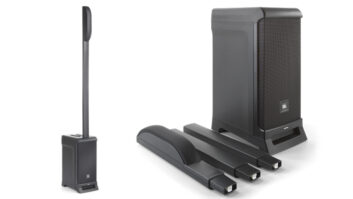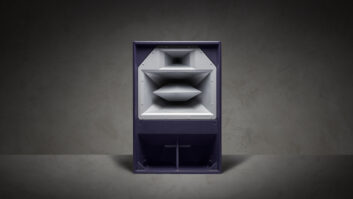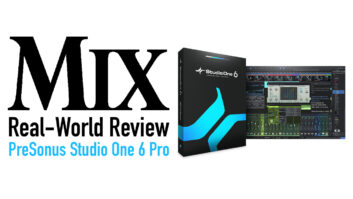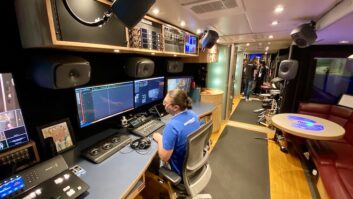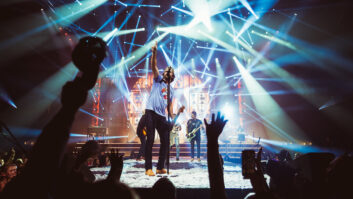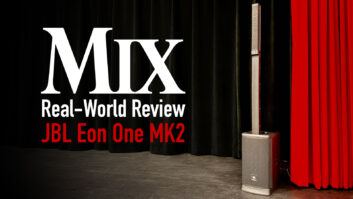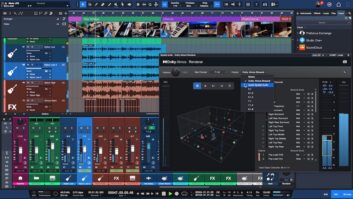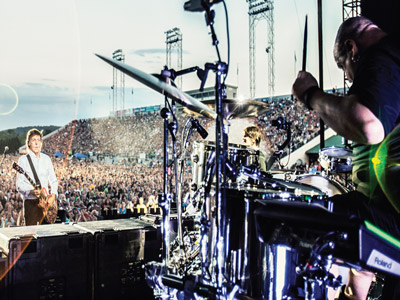
If you’re working front-of-house for a rock legend—like Sir Paul McCartney—you know the nuances of a vast and various number of venues, no matter how similar some may seem. Just ask Paul “Pab” Boothroyd.
During his recent One on One tour, McCartney made his first-ever visit to Hershey, Pa., on a summer’s night at Hersheypark Stadium, which comprises two football field–long sections of concrete grandstands (and little else), with the stage in one end zone and the other open-ended; later in the tour came a two–nighter at Washington, D.C.’s, Verizon Center, a typical indoor sports arena.
With the last leg of One on One in the rear view, McCartney’s band of about 15 years— which includes guitarists Rusty Anderson and Brian Ray, keyboardist Paul “Wix” Wickens and drummer Abe Laboriel, Jr.—and the crew are preparing for two nights in Sacramento, Calif., before two highly-anticipated, open-air concerts during Desert Trip, in the Southern California town of Indio, on October 8 and 19.
Boothroyd—or “Pablo on the sound,” as Sir Paul likes to shout-out—has been McCartney’s soundman since he returned to the road after the release of Flowers in the Dirt in 1989. He has been mixing McCartney’s latest worldwide trek from an Avid Venue S6L console.
TECH HAPPY
Boothroyd has been mixing since late last year on the Avid S6L, which features full 96kHz Pro Tools integration, making it a fine choice for archiving the content from McCartney’s 2-hour, 45-minute shows.
The S6L is “stable and I have no problems with it,” Boothroyd says, noting the ease of making software updates and tweaks. “It’s very powerful and has massive capability.”
The S6L supports more than 300 processing channels; the real-time HDX-powered DSP engine handles all routing, channel and mixing functions, as well as managing all plugin processing, with full automatic delay compensation. It also allows for easy access and adjustment to the mix, including plug-ins and VCA groups, via its touchscreen and surface controls. It also offers insight into every input and auxiliary through the Universe screen.
Essentially, the S6L allows Boothroyd to create bigger, better mixes. That’s crucial for an artist like McCartney, who plays a varied set, from staples like “Band On The Run” to occasional inclusions, like “A Day In The Life,” which encompass varied style sequences.
“There are endless capabilities within a song,” he says, noting that he also still mixes manually, like at the end of “Golden Slumbers/Carry That Weight/The End.” “I don’t get too tricky with it. People and engineers need to remember that the sound comes from the source. I fine-polish my end, but I don’t overdo it.”
INSIDE/OUT
The P.A. system comprises three hangs (16, 12 and eight CO-12s) from Lititz, Pa.-based Clair Brothers’ Cohesion Series, with 12am wedges and R4 sidefills (with an additional in-ear monitor for Wix). It’s all run from an analog Midas Heritage H3000, with a sidecar run by monitor engineer John “Grubby” Callis.
The speaker arrangement is also a new for the crew, says system engineer Dave Coyle. “We’re trying to cover 360 degrees,” he says, noting that the old speakers weighed 255 pounds each, and the new Clair models only weigh 149 pounds each. “I can run them off of a single-amp power source. That’s half of the energy we used to need.”
The CO-12s also affect the way that Boothroyd mixes the show (he mentions that earplugs are not needed at a McCartney performance). “The levels are about 105 decibels for the heavier songs, about 90 for acoustic.” Coyle explains. “The sound is nice and clean, not brittle.”

System engineer Dave Coyle, left, of Clair Brothers, and McCartney front-of-house stalwart Paul “Pab” Boothroyd, hit the Pause button after soundcheck for a quick snap on McCartney’s second night at Washington, D.C.’s Verizon Center.
For mics across the stage, Boothroyd explains that he doesn’t “just stick to one brand because of freebies. I use the right mic for the task at hand, and we also have a lot of pyro and concussion during ‘Live And Let Die,’ so it’s not like I’m gonna use fancy, vintage stuff or ribbons, as they would just get punished.”
It’s mainly Audix/DPA on the drums, with a RØDE and Shure mix on guitars. “They seem to be doing their jobs just fine,” Boothroyd says.
Boothroyd, who also tours extensively with AC/DC and has worked with the likes of Paul Simon and Faith Hill, also chimes in on how McCartney tours often include a mix of indoor and outdoor shows, though he prefers stadium dates. “A sold-out stadium, that’s the best feeling ever,” he says. In the case of Hersheypark Stadium: “It’s open and long, so the sound washed right over the audience and escaped beautifully.”
Sports arenas, on the other hand, present various challenges. “They’re generally not designed with acoustics for music in mind, because for sports, they want the crowd to sound big,” he says. So Boothroyd scans each arena for normal reflections. “Corporate facilities are built with concrete and glass, and plate glass is highly reflective, so you avoid it,’ he explains. “Plus, you may have a scoreboard to deal with.”
As sports arenas go, he says Verizon Center “isn’t so bad, because of the relatively small amount of glass in the seating bowl and the acoustic panels in the ceiling. In many sports arenas, [making that addition] is a cost issue.”
Another circumstance to address with McCartney shows is the fact that, oddly enough, his shows sell well. “That means that the front-of-house is always moved back on the floor,” Boothroyd said. “That’s not the best place to mix.”
DESERT STORM?
Then, there are locations like the Desert Trip, which was held in mid-October at the Coachella/Stagecoach site, at Empire Polo Grounds in Indio, Calif. It “includes numerous areas for the festivalgoers to hang out,” Boothroyd says. “It’s going to be one big stage in the middle of one end of the field,” with two outer sections of temporary seats.
“But the main problem [with this setup] is that the site is very, very wide,” he says. “The careful placement of audio delay towers has already been worked out” by Clair Global. “I believe we have 36 delay locations, with, of course, substantial stage hangs, with subs and front fill as necessary.”
While that sounds great, Boothroyd knows what can happen during an outdoor show and always offers a nod to Mother Nature.
“I think the biggest problem could be wind, or even dust, storms,” he says. “Let’s just hope it’s a peaceful evening.”

